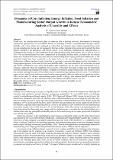| dc.description.abstract | World over, the manufacturing sector plays an important role in spurring economic development by boosting
employment opportunities for semi-skilled labour and building a nation’s competitiveness through exports.
Globally, only a few nations have managed to realize their development status without manufacturing sector
playing a leading role. Kenya has not managed to develop a robust manufacturing sector and its growth has been
majorly ascribed to the agricultural and service sectors. It has therefore, experienced de industrialization as
evidenced by the decline in GDP contribution by the manufacturing sector from a paltry 10% in 2018 to 9.7% in
2019. The de industrialization has been characterized by fluctuating inflation rates, a scenario that has elicited
debate as to whether there exists any nexus between manufacturing sector output growth and inflation rate. A few
empirical studies have been conducted on the same, however, the exact relationship is not well defined.
Furthermore, inflation has been largely treated as an aggregate, a scenario that hampers policy formulation. A
disaggregated approach to the analysis thus motivated this study. Time series data from the world bank was used
and VECM estimated to assess long run dynamics after stationarity test by ADF and Cointegration test by
Johannes’s approach. Short run causalities were assessed via Wald test. The study revealed long run relationship
between manufacturing output growth and the variables (core inflation, energy inflation and food inflation). Short
run causality running from each of the inflation types to manufacturing output growth also exists. Food inflation
negatively and significantly influences manufacturing output growth while core inflation has significant positive
effect on the same. To enhance manufacturing output growth in Kenya, food inflation should be reduced and
stabilized. In the same vain, low and stable level of core inflation should be ensured over time | en_US |

